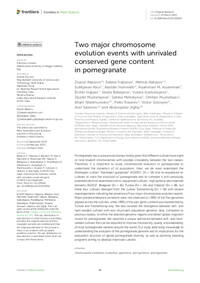Two major chromosome evolution events with unrivaled conserved gene content in pomegranate

Authors:
Pomegranate has a unique evolutionary history given that different cultivars have eight or nine bivalent chromosomes with possible crossability between the two classes. Therefore, it is important to study chromosome evolution in pomegranate to understand the dynamics of its population. Here, we de novo assembled the Azerbaijani cultivar “Azerbaijan guloyshasi” (AG2017; 2n = 16) and re-sequenced six cultivars to track the evolution of pomegranate and to compare it with previously published de novo assembled and re-sequenced cultivars. High syntenywas observed between AG2017, Bhagawa (2n = 16), Tunisia (2n = 16), and Dabenzi (2n = 18), but these four cultivars diverged from the cultivar Taishanhong (2n = 18) with several
rearrangements indicating the presence of two major chromosome evolution events. Major presence/absence variations were not observed as >99% of the five genomes aligned across the cultivars, while >99% of the pan-genic content was represented by Tunisia and Taishanhong only. We also revisited the divergence between soft- and hard-seeded cultivars with less structured population genomic data, compared to previous studies, to refine the selected genomic regions and detect global migration routes for pomegranate. We reported a unique admixture between soft- and hardseeded cultivars that can be exploited to improve the diversity, quality, and adaptability of local pomegranate varieties around the world. Our study adds body knowledge to
understanding the evolution of the pomegranate genome and its implications for the population structure of global pomegranate diversity, as well as planning breeding programs aiming to develop improved cultivars.
